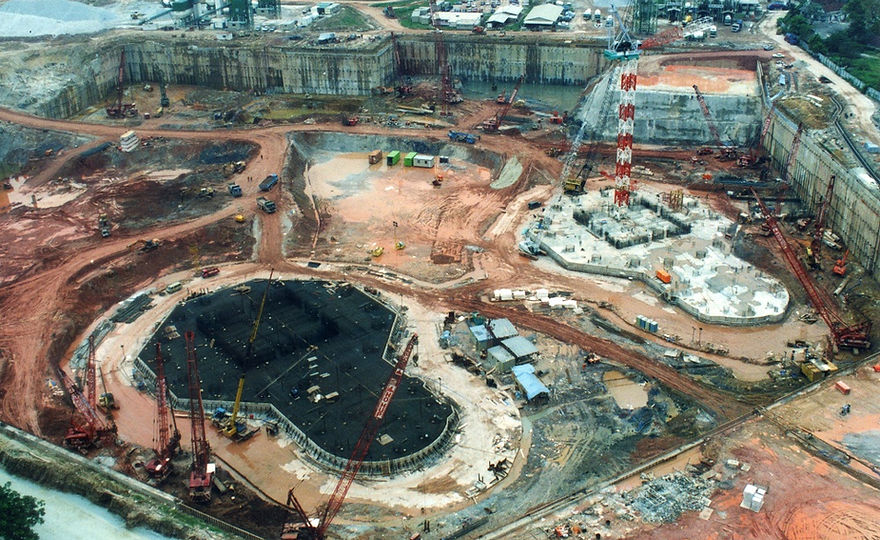Historical Development
Let us delve into the historical development of the diaphragm wall technique and the evolution of the equipment associated.

1900-1950
The work in the years 1900-1950 concentrated on devising the means and methods of stabilizing mine boreholes. The research in this era was fueled by the boom in the mining sector.
1913: First publications on the stabilizing effects of slurry in bore holes.
1920: Use of slurry reverse circulation in mine boreholes.
1927: The Peterfi and Freundlich definition of thixotropy in colloid suspensions.
1929: The use of bentonite in drilling slurry.
1931: The Marsh invention of the viscosimeter called the “Marsh cone” used to check the state of slurry.
1938: Veder, the Italian engineer, designed the principle of a diaphragm wall in a slurry trench.
1948: The first “slurry trench” cut-off excavated on Terminal Island, in Long Beach, California.
1949: Industrialization of slurry drilling by Solétanche for constructing a 1.00 m diameter and 65.00 m deep pile for the Bone (Annaba) electricity power plant in Algeria.

1951-2000
The work in the years 1951-2000 concentrated on devising the means and methods of constructing diaphragm walls. A great deal of research evolved around the equipment required to mechanize deep excavation. The research in this era was fueled by the boom in the construction of public infrastructure post the World Wars.
1953: Marconi, the Italian engineer invented a machine which travels on rails and which constructs panels by percussion excavation through mud, removing spoil by reverse circulation.
1958: First slurry trench cut-off constructed in France.
1959: Construction in France of the C.I.S. machine using the Marconi process; where the ground is excavated using percussion in horizontal layers of increasing depth.
1961: A 9,000m2 diaphragm wall watertight box constructed by Solétanche using a C.I.S machine, as part of the construction of the Marckolsheim hydroelectric power station on the River Rhine.
1962: First commercial applications in Japan.
1963: First diaphragm wall constructed in France, in Paris 8th district, impasse d’Antin, by Solétanche.
1965: First commercial applications in the USA.
1967: Veder analysed the behaviour of bentonite slurry and revealed the existence of and the role played by the “slurry cake”.
1968: Development of a grab attached to a kelly bar.
1970: Development of pre-stressed anchor block used for the first time by Solétanche, on the Peugeot building, avenue de la Grande Armée in the 8th District of Paris.
1972: Development of prefabricated walls for diaphragm walls
1975: Development of a cable grab bucket where pulley bearings and hinges are sealed and pressurized, replacing the bronze bushes that were subject to rapid abrasion and which had to be replaced after each panel/section.
1980: Birth of the elasto-plastic calculation procedure for designing retaining structures and which replace ultimate state calculations.
1988: Construction by Solétanche on the Mud Mountain (Washington, USA) dam of a 1m wide, 124.5m deep diaphragm wall through extremely hard blocks of andesite rock.
1995: Innovation prize awarded to Bachy by the Fédération Nationale des Travaux Publics for the CWS joint, a patented process used to overcome the need for immediate removal of formwork and the installation of a waterstop between adjacent wall panels.
1998: Development of the hydraulic grab, first patents.

2001-2016
The work in the years 2001-2016 concentrated on improving the constructability of diaphragm walls. The current industry has embraced diaphragm walls as load bearing elements especially in private residential and commercial developments. A great deal of research currently revolves around automating the excavation process. The research in this era is fueled by the urban rejuvenation projects in major cities.
2001: First integrated system developed to measure hydraulic grab alignment.
2002: An integrated system developed to measure pressure parameters and the tool trajectory on the wall grab.
2003: The construction by Solétanche and Bachy in Kuala Lumpur (Malaysia) of 125m deep barrettes for the foundations of the Petronas towers.
2005: Innovation prize awarded to Solétanche by the Fédération Nationale des Travaux Publics for the KS 3000 controlled hydraulic grab.
2006: The Target grab developed by Bachy, the ultimate mechanical grab in terms of performance and incorporating an integrated alignment correction mechanism.
2007: The steerable KS2 hydraulic grab, developed by Solétanche Bachy.
2009: The Hydrofraise, a new generation of drilling equipment with a cutting tool arrangement at the bottom of the rig and spoil extracted by reverse circulation, was developed.
2010: The first onboard system designed, to measure the depth and inclination at any point in time of the Hydrofraise drilling rig.
2011: Marine projects : Construction of the port of Le Havre (France) of a 1,602m long quay wall comprising a 1.20m wide diaphragm wall to depths of 42m.
2012: Construction using a Hydrofraise rig with alignment correction, of the Carrousel circular shaft in Versailles (France) which, at a depth of 65m, achieved a verticality tolerance of less than 0.1 %.
2013 : Construction using steel diaphragm wall with soil cement awarded the Certificate for Engineering Technology Evaluation and certified by professional organizations as a wall structure capable of serving as the main body of a structure
